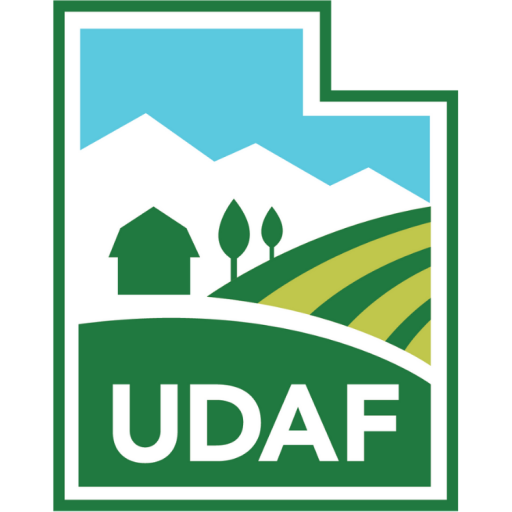Utah Noxious Weed Act (R68-9)
The following weeds are hereby officially designated and published as noxious for the State of Utah, as per the authority vested in the Commissioner of Agriculture and Food under Section 4-17-3:
There are hereby designated five classes of noxious weeds in the state: Class 1A (EDRR Watch List), Class 1 (EDRR), Class 2 (Control), Class 3 (Containment), and Class 4 (Prohibited for sale or propagation).
Class 1A: Early Detection Rapid Response (EDRR) Watch List Declared noxious and invasive weeds not native to the state of Utah and not known to exist in the State that pose a serious threat to the state and should be considered as a very high priority.
Common crupina – Crupina vulgaris
African rue – Peganum harmala
Small bugloss – Anchusa arvensis
Mediterranean sage – Salvia aethiopis
Spring millet – Milium vernale
Syrian beancaper – Zygophyllum fabago
Ventenata (North Africa grass) – Ventenata dubia
Plumeless thistle – Carduus acanthoides
Malta starthistle – Centaurea melitensis
Class 1B: Early Detection Rapid Response (EDRR) Declared noxious and invasive weeds not native to the State of Utah that are known to exist in the state in very limited populations and pose a serious threat to the state and should be considered as a very high priority.
Camelthorn – Alhagi maurorum
Garlic mustard – Alliaria petiolata
Purple starthistle – Centaurea calcitrapa
Goatsrue – Galega officinalis
African mustard – Brassica tournefortii
Giant reed – Arundo donax
Japanese knotweed – Polygonum cuspidatum
Blueweed (Vipers bugloss) – Echium vulgare
Elongated mustard – Brassica elongata
Common St. Johnswort – Hypericum perforatum
Oxeye daisy – Leucanthemum vulgare
Cutleaf vipergrass – Scorzonera laciniata
Class 2: Control Declared noxious and invasive weeds not native to the state of Utah, that pose a threat to the state and should be considered a high priority for control. Weeds listed in the control list are known to exist in varying populations throughout the state. The concentration of these weeds is at a level where control or eradication may be possible.
Leafy spurge – Euphorbia esula
Medusahead – Taeniatherum caput-medusae
Rush skeletonweed – Chondrilla juncea
Spotted knapweed – Centaurea stoebe
Purple loosestrife – Lythrum salicaria
Squarrose knapweed – Centaurea virgata
Dyers woad – Isatis tinctoria
Yellow starthistle – Centaurea solstitialis
Yellow toadflax – Linaria vulgaris
Diffuse knapweed – Centaurea diffusa
Black henbane – Hyoscyamus niger
Dalmation toadflax – Linaria dalmatica
Class 3: Containment Declared noxious and invasive weeds not native to the State of Utah that are widely spread. Weeds listed in the containment noxious weeds list are known to exist in various populations throughout the state. Weed control efforts may be directed at reducing or eliminating new or expanding weed populations. Known and established weed populations, as determined by the weed control authority, may be managed by any approved weed control methodology, as determined by the weed control authority. These weeds pose a threat to the agricultural industry and agricultural products.
Russian knapweed – Acroptilon repens
Houndstounge – Cynoglossum officianale
Perennial pepperweed (Tall whitetop) – Lepidium latifolium
Phragmites (Common reed) – Phragmites australis ssp.
Tamarisk (Saltcedar) – Tamarix ramosissima
Hoary cress – Cardaria spp.
Canada thistle – Cirsium arvense
Poison hemlock – Conium maculatum
Musk thistle – Carduus nutans
Quackgrass – Elymus repens
Jointed goatgrass – Aegilops cylindrica
Bermudagrass* – Cynodon dactylon
Perennial Sorghum spp.: Johnson Grass (Sorghum halepense) and Sorghum almum (Sorghum almum).
Scotch thistle (Cotton thistle) – Onopordum acanthium
Field bindweed (Wild Morning-glory) – Convolvulus spp.
Puncturevine (Goathead) – Tribulus terrestris
*Bermudagrass (Cynodon dactylon) shall not be a noxious weed in Washington County and shall not be subject to provisions of the Utah Noxious Weed Law within the boundaries of that county. It shall be a noxious weed throughout all other areas of the State of Utah and shall be subject to the laws therein.
Class 4: Prohibited Declared noxious and invasive weeds, not native to the state of Utah, that pose a threat to the state through the retail sale or propagation in the nursery and greenhouse industry. Prohibited noxious weeds are annual, biennial, or perennial plants that the commissioner designates as having the potential or are known to be detrimental to human or animal health, the environment, public roads, crops, or other property.
Cogongrass (Japanese blood grass) – Imperata cylindrica
Myrtle spurge – Euphorbia myrsinites
Dames Rocket – Hesperis matronalis
Scotch broom – Cytisus scoparius
Russian olive – Elaeagnus angustifolia
Each county in Utah may have different priorities regarding specific State designated Noxious Weeds and is therefore able to reprioritize these weeds for their own needs.
The Weed Specialist coordinates weed control activities among the county weed organizations and the agricultural field representatives. Surveys of serious weed infestations are conducted and control programs are developed through the county supervisors, county weed boards, and various landowning agencies. The weed specialist and the inspectors work continually with extension and research personnel in encouraging the use of the most effective methods to control the more serious weeds.




